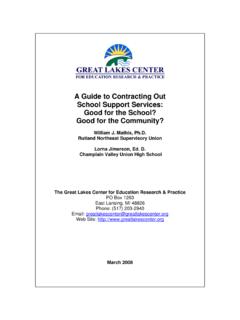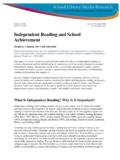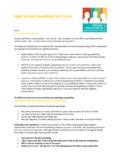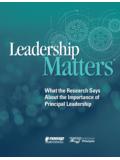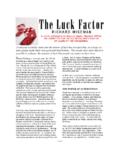Transcription of PISA - OECD.org
1 1 PISA IN FOCUS 2011/9 (October) OECD 2011 PISAS chool autonomy and accountability: Are they related to student performance? In countries where schools have greater autonomy over what is taught and how students are assessed, students tend to perform better. In countries where schools account for their results by posting achievement data publicly, schools that enjoy greater autonomy in resource allocation tend to show better student performance than those with less autonomy. In countries where there are no such accountability arrangements, schools with greater autonomy in resource allocation tend to perform FOCus9education policy education policy education policy education policy education policy education policy education policyin recent years, many schools have grown into more autonomous organisations and have become more accountable to students, parents and the public at large for their outcomes.
2 PisA results suggest that, when autonomy and accountability are intelligently combined, they tend to be associated with better student performance. school autonomy in allocating resources is greatest in the Czech Republic, the netherlands, the partner country Bulgaria and the partner economy Macao-China. in all of these, over 90% of students attend schools that have the authority to hire and dismiss teachers, and over 90% of students attend schools that, along with a regional or national education authority, are responsible for formulating and allocating budgets. in contrast, in Greece, italy, Turkey and the partner countries Romania and Tunisia, over 80% of students attend schools that have no authority to hire or dismiss teachers; only regional or national education authorities do.
3 The Czech Republic, the netherlands, the united Kingdom and the partner economy Macao-China grant the greatest autonomy to schools not only in allocating resources but also in making decisions about curricula and assessments. Greece, Turkey and the partner countries Jordan and Tunisia grant the least autonomy to schools in making decisions about curricula and assessments and in allocating resources. Japan, Korea, new Zealand and the partner economy Hong Kong-China grant relatively greater autonomy to schools in determining curricula and assessment practices. in these countries, over 80% of students attend schools that have considerable responsibility for establishing student-assessment policies, choosing which textbooks are used, and deciding which courses are offered.
4 However, these countries do not grant much autonomy to schools for allocating resources. in contrast, the partner country Bulgaria and the partner economy shanghai-China grant relatively high levels of autonomy to schools for allocating resources, but not for determining curricula and assessment degree and types of school autonomy vary widely among FOCusPISA IN FOCUS 2011/9 (October) OECD 20112 Levels of school autonomy and accountablity across PISA countries and economiesAustraliaAustriaBelgiumCanadaCh ileCzech RepublicDenmarkEstoniaFinlandGermanyGree ceHungaryIcelandIrelandIsraelItalyJapanK oreaLuxembourgMexicoNetherlandsNew ZealandNorwayPolandSlovak RepublicSloveniaSpainSwedenSwitzerlandTu rkeyUnited KingdomUnited StatesAlbaniaArgentinaAzerbaijanBrazilBu lgariaColombiaCroatiaDubai (UAE)
5 Hong Kong-ChinaIndonesiaJordanKazakhstanKyrgy zstanLatviaLiechtensteinLithuaniaMacao-C hinaMontenegroPanamaPeruPortugalQatarRom aniaRussian FederationSerbiaShanghai-ChinaSingaporeC hinese TaipeiThailandTrinidad and autonomy in resource allocationSchool autonomy in curriculum and assessmentPercentage of students in schools that post achievement data publiclyOECD average: 37%AutonomyAccountabilityAt the country level, the greater the number of schools that have the responsibility to define and elaborate their curricula and assessments, the better the performance of the entire school system, even after accounting for national income. school systems that grant schools greater discretion in deciding student-assessment policies, the courses offered, the content of those courses, and the textbooks used are also those systems that show higher reading scores overall.
6 This association is observed even though having the responsibility to design curricula is not always related to better performance for an individual school . in contrast, there is no clear relationship between autonomy in resource allocation and performance at the country level. This may be because how resources are distributed tends to benefit individual schools but does not necessarily affect a system s overall performance. Data from PisA show that the relationship between the performance of individual schools and their level of autonomy in allocating resources is positive in some countries and negative in others. For example, in Chile, Greece, Korea and the partner country Peru, schools that have greater autonomy in allocating resources also achieve higher scores in reading, while in switzerland and the partner countries Colombia, Croatia, Kyrgyzstan and Thailand, schools that have greater autonomy in this area do not perform as autonomy is related to student : Positive values on the index indicate that individual schools assume more responsibility than local, regional or national education authorities, compared with the OECD average.
7 Negative values indicate that local, regional or national education authorities assume more responsibility than individual schools, compared with the OECD average. source: OECD, PISA 2009 FOCusPISA IN FOCUS 2011/9 (October) OECD 2011 AuTOnOMY in REsOuRCE ALLOCATiOnPISA 2009 asked school principals to report whether principals , teachers , a school governing board , a regional or local education authority or a national education authority has considerable responsibility for: selecting teachers for hire; dismissing teachers; establishing teachers starting salaries; determining teachers salary increases; formulating the school budget; and deciding on budget allocations within the school . The ratio of the number of these six activities for which principals and/or teachers have responsibility to the number of these activities for which a regional or local education authority and/or a national education authority has authority was computed.
8 PisA results show that in school systems where most schools post achievement data publicly, average student performance is marginally higher in those schools that have autonomy over resource allocation. Across OECD countries, an average of 37% of students attend schools whose principals reported that they make achievement data available to the public, while in Austria, Belgium, Finland, Japan, spain, switzerland, the partner countries Argentina, Panama, Tunisia, uruguay and the partner economy shanghai-China, fewer than 10% of students attend schools that make performance data publicly available. in contrast, in the united Kingdom, the united states, and the partner countries Azerbaijan and Kazakhstan, more than 80% of students attend such in CuRRiCuLA AnD AssEssMEnTsPISA 2009 asked school principals to report whether principals , teachers , a school governing board , a regional or local education authority , or a national education authority has considerable responsibility for: establishing student-assessment policies; choosing which textbooks are used; determining course content; and deciding which courses are offered.
9 The ratio of the number of these four activities for which principals and/or teachers have responsibility to the number of these activities for which a regional or local education authority and/or a national education authority has responsibility was computed..particularly when autonomy is combined with FOCusPISA IN FOCUS 2011/9 (October) OECD 20114 Coming next monthWhat can parents do to help their children succeed in school ? For more information Contact Miyako ikeda PISA 2009 Results, What Makes a school Successful? Resources, Policies and Practices (Volume iV).The bottom line: Autonomy and accountability go together: greater autonomy in decisions relating to curricula, assessments and resource allocation tend to be associated with better student performance, particularly when schools operate within a culture of short, school autonomy in allocating resources tends to be associated with good performance in those education systems where most schools post achievement data publicly.
10 This suggests that it is a combination of several autonomy and accountability policies, not just a single, isolated policy, that is related to better student complex relationship between policies and performance500490480 PISA reading scoreSystems with more accountabilitySystems with less accountabilityNote: In school systems in OECD countries where all schools post achievement data publicly, a student who attends a school with more autonomy in allocating resources than the average school tends to score five points higher on the PISA reading test than a student who attends a school with less autonomy. In contrast, in school systems where no schools post achievement data publicly, a student who attends a school with more autonomy in resource allocation tends to score six points lower on the reading test than a student who attends a school with less autonomy.











